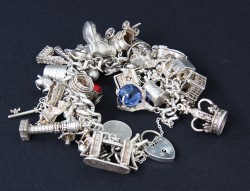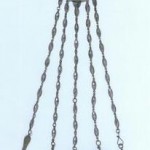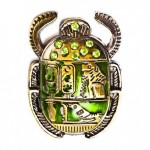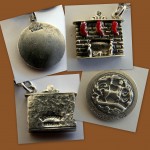Vintage Charm Bracelets in Modern History
Charms and amulets of one sort or another have been around for thousands of years. They are well documented in ancient Egypt, Rome, and many other historical eras as talismans worn to ward off evil spirits or bring luck. For this article I’m focusing on the rise in popularity of charms and charm bracelets in recent times.
England’s Queen Victoria wore charms on bracelets and necklaces throughout her reign, and is credited with starting a fashion trend among Europeans. Charms of the Victorian era were likely made from sterling silver and often included gemstones. The styles included puffy hearts, lockets, coins, and mechanical charms which had a moving part.
Mourning charms were also popularized by Queen Victoria. These were usually some type of locket or tiny container filled with hair cut from a deceased loved one. She wore the hair of her beloved Prince Albert in a tiny compartment after his death. Other common trinkets women wore as charms were teeth & claws, stones, and shells. These usually represented something meaningful or lucky to the owner.
Moving into the 20th century and the industrial revolution, manufacturers began turning out charms of other materials and styles. With the Art Nouveau period of the early 1900s there were flowing forms of ornate flowers and animals. During the 1920s and 1930s Art Deco was all the rage and the charms became more geometric and angular. Also during this period designers began to incorporate ivory, animal teeth & bone, wood, plastics, and other materials into jewelry of all types.
Some fashion icons of the early 20th century that helped fuel the charm bracelet craze were the Duchess of Windsor, and designers Coco Chanel, and Elsa Shiaparelli. The Duchess of Windsor wore a Cartier bracelet of nine small crosses, each made from precious gemstones on her wedding day. The bracelet was a gift from her husband. Both Coco Chanel and Elsa Shiaparelli wore large fob style bracelets in public, and carried them in their jewelry lines. Their bracelets were reproduced by jewelry houses both in Europe and in America and available at prices that were affordable to the masses.
During the 1950s charm bracelets were more popular than ever and there were a few designers and companies that created the most sought after treasures of the period. One was Walter Lampl. He is most famous for his enamel hearts, but he also created an assortment of styles that appealed to a wide spectrum of women and girls and represented special moments and events in their lives. It became customary for girls to begin charm bracelets when they were young and add to them during the phases of their lives. The Lampl charms of the 1950s are some of the most desirable for collectors today and can fetch several hundred dollars for a sterling charm.
The 1950s were the golden years for charm bracelets. They were spotted in magazines on the arms of celebrities and politicians wives. Mamie Eisenhower and Jacqueline Kennedy showed off their bracelets in photos of the period. Elizabeth Taylor had a large collection of charm bracelets and wore one almost everywhere. Lucille Ball wore a musical theme bracelet that was presented to her by her musician husband Desi Arnaz.
Women often bought bracelets for themselves and added a charm for each special event in their lives. Travel became more common among everyday families and wives purchased travel souvenirs from tourist spots. They started bracelets for their young daughters, adding memento charms as they grew, thereby passing the tradition to the next generation.
The women's movement of the 1960s ended the explosion of popularity for the charm bracelet. But only temporarily, thank goodness. The marriage, homemaker, and motherhood goals of earlier times were replaced with freedom and career ideals and charm bracelets seemed out of touch. Besides who would wear a dangly dainty charm bracelet with hippee beads and bell bottoms?
Now everything old is collectible again and charm bracelets are hotter than ever. Vintage charms of yesteryear are available and affordable thanks to the internet. On-line charm discussion forums are easy to join. There are groups devoted to charm collecting on Facebook. Collectors write books and articles making it easy to educate one's self about various styles and designers. Clubs with members around the world meet to exchange ideas, show off their collections, and trade charms. It's an addicting passion but one that is growing swiftly. Being able to wear your collection is an added bonus and makes it all the more exciting. Add to that the investment potential of precious metals and gems and it's easy to see why a charm bracelet is an accessory that's here to stay.

More from my site
Category: All About Old Jewelry










